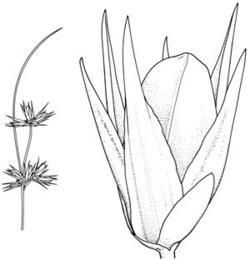Juncus homalocaulis F.Muell. ex Benth. APNI* Synonyms: Juncus plebeius auct. non R.Br. APNI*

Description: Tufted, shortly rhizomatous perennial, often with fibrous remains of leaf sheaths persistent at base. Culms terete to compressed, 5–35 cm long, 0.5–1.2 mm diam.
Leaves basal, from shorter than to rarely slightly longer than culms; blade filiform or canaliculate, 0.3–0.9 mm wide; auricles ≤ 0.5 mm long; sheath pale yellowish.
Inflorescence terminal, diffuse, 2–11 cm long; flowers clustered or occasionally solitary, (1-)5–36 flowers per cluster and 2–4(-8) clusters per inflorescence; involucral bract 1, well-developed, 2–15 cm long, generally longer than or equalling inflorescence but occasionally shorter. Tepals straw-brown, occasionally red-brown, with broad hyaline to pale yellowish margins; outer tepals 5.0–6.0 (rarely to 7.5) mm long, longer than inner tepals. Stamens 3 (occasionally 4–6), shorter than outer tepals; anthers 0.7–1.3 mm long.
Capsule shorter than to rarely longer than outer tepals, ovoid to ellipsoid, acute to acuminate, apiculate, golden brown (rarely red-brown).
Flowering: spring–summer.
Distribution and occurrence: Grows in woodland and grassland, common on Tablelands and Western Slopes, rare on NC ranges (Beaury Creek) and in Hunter Valley, and west to Warrumbungle Ra. and Tocumwal area.
NSW subdivisions: NC, CC, SC, NT, CT, ST, NWS, CWS, SWS, SWP
Other Australian states: Qld Vic. S.A.
Text by K. L. Wilson, L. A. S. Johnson & P. Bankoff (1993); edited KL Wilson (Nov 2022)
Taxon concept: Flora of NSW 4 (1993)
APNI* Provides a link to the Australian Plant Name Index (hosted by the Australian National Botanic Gardens) for comprehensive bibliographic data
***The AVH map option provides a detailed interactive Australia wide distribution map drawn from collections held by all major Australian herbaria participating in the Australian Virtual Herbarium project.
|


